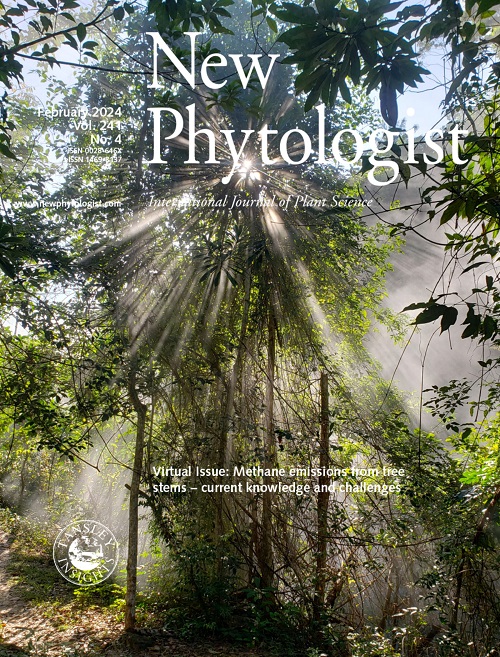Intraspecific variation in realized dispersal probability and host quality shape nectar microbiomes
IF 8.1
1区 生物学
Q1 Agricultural and Biological Sciences
引用次数: 0
Abstract
- Epiphytic microbes frequently affect plant phenotype and fitness, but their effects depend on microbe abundance and community composition. Filtering by plant traits and deterministic dispersal-mediated processes can affect microbiome assembly, yet their relative contribution to predictable variation in microbiome is poorly understood.
- We compared the effects of host-plant filtering and dispersal on nectar microbiome presence, abundance, and composition. We inoculated representative bacteria and yeast into 30 plants across four phenotypically distinct cultivars of Epilobium canum. We compared the growth of inoculated communities to openly visited flowers from a subset of the same plants.
- There was clear evidence of host selection when we inoculated flowers with synthetic communities. However, plants with the highest microbial densities when inoculated did not have the highest microbial densities when openly visited. Instead, plants predictably varied in the presence of bacteria, which was correlated with pollen receipt and floral traits, suggesting a role for deterministic dispersal.
- These findings suggest that host filtering could drive plant microbiome assembly in tissues where species pools are large and dispersal is high. However, deterministic differences in microbial dispersal to hosts may be equally or more important when microbes rely on an animal vector, dispersal is low, or arrival order is important.
花蜜微生物群的已实现扩散概率和宿主质量的种内变异
表生微生物经常影响植物的表型和适应性,但它们的影响取决于微生物的丰度和群落组成。通过植物特征和确定性扩散介导的过程进行过滤可能会影响微生物组的组装,但它们对微生物组可预测变异的相对贡献尚不清楚。我们比较了寄主植物过滤和扩散对花蜜微生物组存在、丰度和组成的影响。我们将具有代表性的细菌和酵母接种到四个表型不同品种的30株植物中。我们将接种疫苗的群落的生长与来自同一植物子集的公开参观的花朵进行了比较。当我们给花接种合成群落时,有明显的寄主选择的证据。然而,接种时微生物密度最高的植物在公开参观时微生物密度并不最高。相反,可以预见的是,植物在细菌的存在下会发生变化,这与花粉的接收和花的特征有关,这表明了确定性传播的作用。这些发现表明,宿主过滤可以驱动植物微生物组在物种库大、扩散率高的组织中组装。然而,当微生物依赖动物载体、传播率低或到达顺序重要时,微生物传播到宿主的确定性差异可能同样或更重要。
本文章由计算机程序翻译,如有差异,请以英文原文为准。
求助全文
约1分钟内获得全文
求助全文
来源期刊

New Phytologist
PLANT SCIENCES-
CiteScore
17.60
自引率
5.30%
发文量
728
审稿时长
1 months
期刊介绍:
New Phytologist is a leading publication that showcases exceptional and groundbreaking research in plant science and its practical applications. With a focus on five distinct sections - Physiology & Development, Environment, Interaction, Evolution, and Transformative Plant Biotechnology - the journal covers a wide array of topics ranging from cellular processes to the impact of global environmental changes. We encourage the use of interdisciplinary approaches, and our content is structured to reflect this. Our journal acknowledges the diverse techniques employed in plant science, including molecular and cell biology, functional genomics, modeling, and system-based approaches, across various subfields.
 求助内容:
求助内容: 应助结果提醒方式:
应助结果提醒方式:


